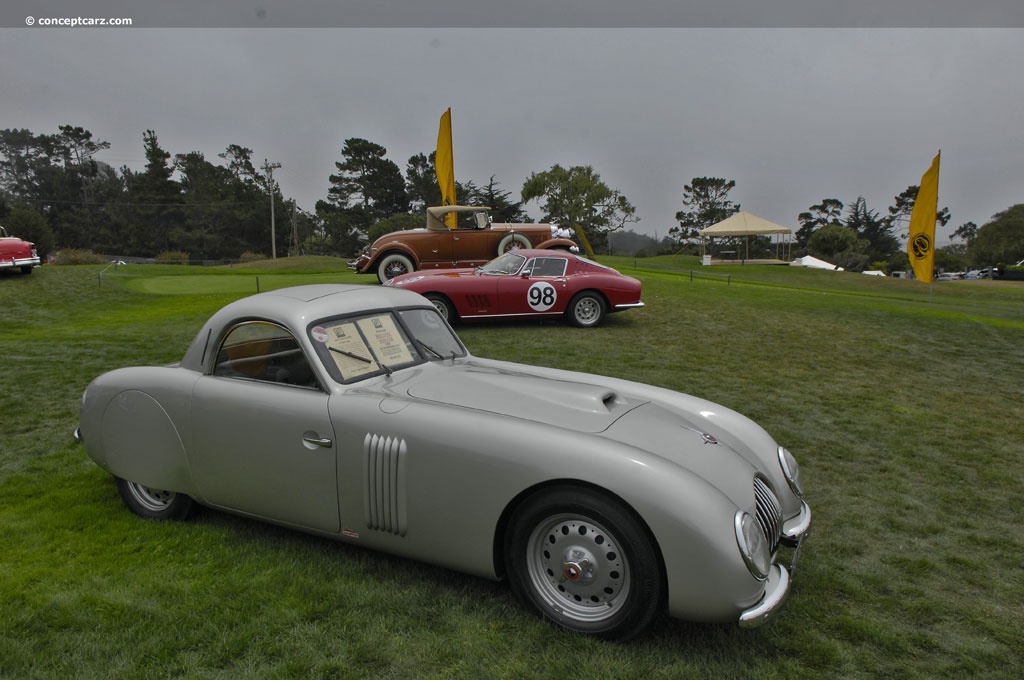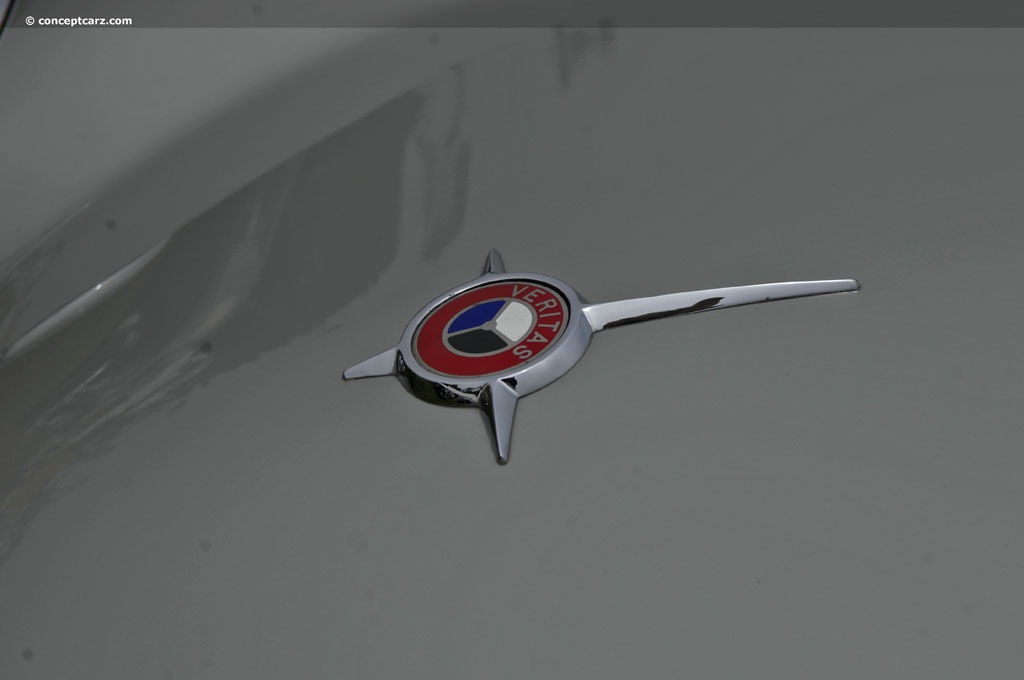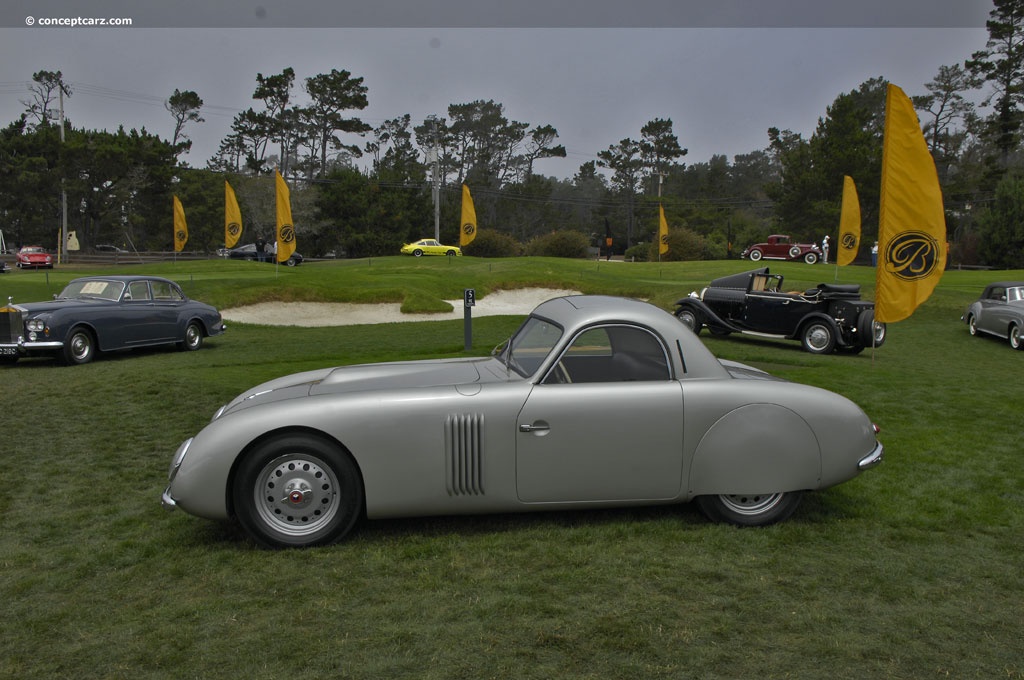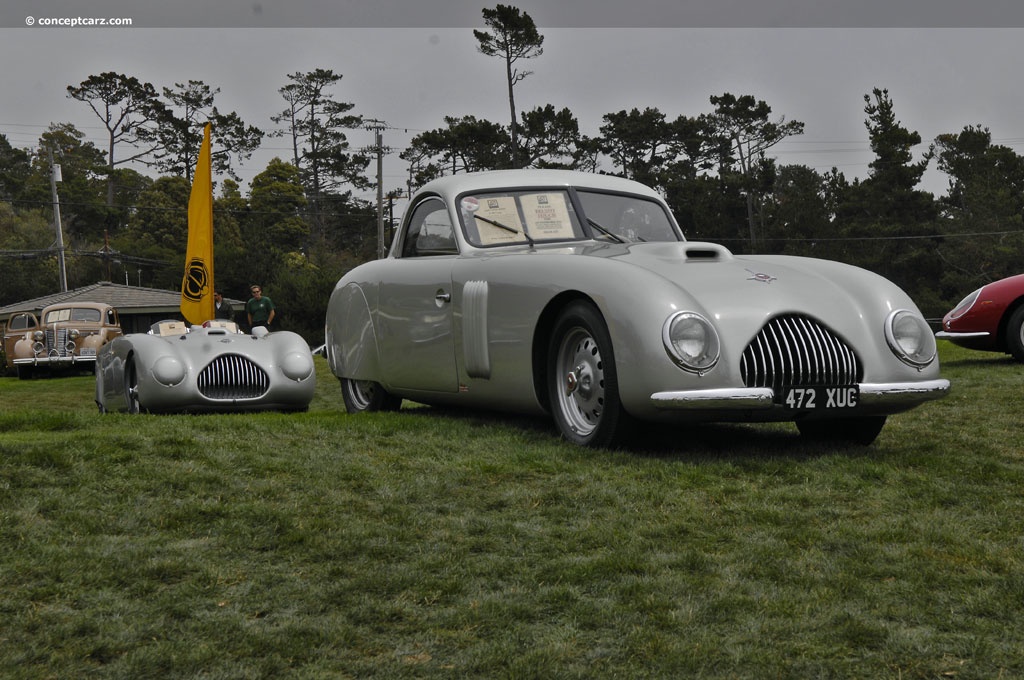Founded by the pre-war top brass from BMW, the Veritas automobile company built 10 Formula 2 single-seater sports vehicles, a few Formula 2 cars, and sports racing vehicles. The company is famed for being a well-known West German post-WW II sports and race car company, that was located at Hausen am Andelsback, near Sigmaringen, Baden- Württemberg. Eventually, the company was moved to Meßkirch and Muggensturm and then finally moved to the Nürburgring. The company is also quite famous for being perhaps the only professional German effort in premier-level post-war racing, though it never really reached a true manufacturer's status. Veritas was also the only German company of 'some recognizable international presence and reputation in that period'.The founders of Veritas were Ernst Loof, Georg Meier, and Lorenz Dietrich who originally re-built and tuned pre-war BMW 328 vehicles with components that were provided by a customer, and turned them into BMW-Veritas cars. Becoming the 1947 German 2-liter champion was the first vehicle used by its owner Karl Kling to win at Hockenheim. Following an objection from BMW, and after only a few vehicles were made, the cars were simply dubbed as Veritas.
In 1949 the first Veritas vehicles were produced and were capable for normal road use with the introduction of the Komet coupe which was basically a racing Veritas RS that was made street-legal. Following the coupe was a much more civilized 2x2 Saturn coupe and Scorpio cabriolet. In this same year, the Veritas Company moved to a larger building in Muggensturm but unfortunately were badly undercapitalized. Designed by Eric Zipprich, new cars were designed using a 1998 cc engine that was built by Heinkel. More than 200 orders for the new car flowed in, but not enough money was available to purchase the components. Production skirted to a halt in 1950 and the company continued in operation until 1952 by making new bodies for Panhard vehicles. The main 'figure' behind the formidable Veritas Company was Ernst Loof who had previously been a member of the BMW race department and later chief of the styling department after the war, he was also famous for the BMW 328 Mille Miglia design. Following the war, Loof bought the former Mille Miglia Streamliner, and it was in this car that Hermann Lang won the very first post-war race in German during the Ruhestein hill climb of 1946.At this time in history, Germany remained under allied rule and Loof was only allowed to establish vehicle production only in the French occupation zone by officials. Dietrich chose to name the company after the French company Bureau Veritas, which was famous for classifying ships. An old mill in the area of Baden, Southwest Germany, French authorities granted them an old mill where the company took up business in March 1947. Their original designs were as were to be expected, based on the very successful pre-war BMW 328, which has remained the backbone of German motorsport activities well into the 1950s.
In 1950, Ernst Loof relocated to Nürburgring. He rented the old Auto Union workshops and set up a new company' Automobilwerke Erst Loof GmbH and began a new range of Veritas vehicles at first with the Heinkel manufactured engine and saloon or cabriolet coachwork by Spohm. Unfortunately, money soon ran out and the final bodies were fitted with Opel or Ford engines. A total ranging between 6 through 20 vehicles were produced at Nürburgring. A long-time friend of Loof, Karl Kling used to watch the original Veritas sports cars nearing completion, and he wanted one but didn't have enough funds to purchase one. He then persuaded Loof to hand him the construction plans so he could build one himself, which he then took to Stuttgart and built in the garage of Richard Bez. This completed vehicle was ready just in time for the Stadtparkrennen, and Kling set the best practice time from the beginning. Unfortunately, he was overambitious and attempted to go faster and this is where he crashed and damaged the car beyond repair. He could no longer take any part in the race. In 1948 was the start of the 2-liter sports car class at Hockenheim and three of the new Veritas RS debuted. Production of the Veritas automobiles was moved to a new facility at Messkirch during the winter of 1947 and 1948. Four brand-new Veritas sports vehicles debuted at Hockenheim this year.Nicknamed 'bathtub', the all-new Veritas RS was based on a very lightweight body that combined tube section/spaceframe chassis that weighed only 36 kg. This was all covered by an all-encompassing streamlined bodywork and fitted with the standard BMW 328 suspension. The BMW 328 engine was available in either 2 or 1.5-liter form. This design was Veritas's claim to pioneering German post-war racing at a time in the world when the majority of customers were left to rely on outdated pre-war machinery or home-built specials. The German public was very excited about the debut at Hockenheim.At Hockenheim in 1948, there was a new debut, another Veritas RS, placed in the race car class. This newest vehicle featured a unique BMW engine with three camshafts that delivered 140hp. By 1949, Veritas had dominated the 2-litre sports car class at Hockenheim, Schotten, Tübingen, Nürburgring, the Schauinsland hillclimb, the Eifelrennen, and the Solitude. Only twice was Kling defeated. During 5 FIA World Championship races, a total of 17 privately-entered Veritas cars participated. Nearly 50 years later after their virtual disappearance from motor racing and automotive engineering, a small company dubbed Vermot AG had plans to 'resurrect' the Veritas name on a planned model that was known as the RS III.In 1949, the German public excitedly waited for Veritas's new Formula 2 monoposto, but unfortunately, the model completion was held back while Veritas searched for a suitable engine. The car debuted briefly at the 1948 Eggberg hillclimb that was intended to be driven by Heinrich Herbster. Unfortunately, the large Bugatti 2.3-liter engine was too big and there was not enough space left in the cockpit for the driver's legs, and the vehicle was later fitted with either a BMW or an earlier Meteor engine that was sold to American Alexander Orley. Since the Veritas name sounded too 'German' the new vehicle was entered under such pseudonyms like Orley Special or even Todd Special. Unfortunately, the construction of a new Meteor engine meant that further delay would hold back the appearance of the Veritas single-seater. Drivers like Toni Ulmen had to utilize the company's conventional RS sports vehicle as a stop-gap for the Formula 2 races. The car was extremely reliable and very speedy, especially on high-speed circuits like Grenzlandring and Hockenheim. Veritas claimed the title in all three classes in which they had constructed suitable vehicles for.Near the end of the 1949 model year, the Veritas future was looking bright. In the meantime, their new Formula 2 monoposto was finally completed, just in time for the last race of the season at Cologne. It was entrusted to the dominant driver of the early years, Karl Kling. Thankfully the design was loved by the public and Kling initially battled for the lead with Hans Stuck in the AFM. Unfortunately, he spun and stalled, which finally lead to his disqualification.
Around this same time, the company had taken up serial production of a road-going version of the RS. (This had been Germany's most powerful and most expensive vehicle at the time.) At the same time, a contract had been put into place with the French Panhard concern for license production of the well-like Dyna. At the beginning of 1950, the ban on German cars and drivers at foreign events was suspended, and new financial chances opened up in the international race car market. At the same time, the local German economy was still very poor following the war. At the same time, public opinion towards German racing activities still connected with Mercedes and Auto Union's pre-war domination, and the Veritas Company was due to continue this tradition following their successes in 1949. Quite a few orders though were processed for their new Meteor Formula 2 car.
Rather than concentrating on the completion and construction of his customer's vehicles, Loof instead was running the company on a 'hand-to-mouth' basis and had already spent money to build up the serial production of the road-going touring vehicles. And once again, the company changed its location once again and moved to a factory at Muggensturm near Rastatt.
Loof's customers eventually became impatient, and the vehicles were constructed hastily severely lacking in finish and reliability. The deficiencies were found later on when the vehicles raced against international opposition, rather than being evident in the short German events, where most races were run over distances between 50 and 100km. unfortunately, this compromised Veritas's reputation and orders ran dry, which only increased the company's financial crisis. Veritas went bankrupt in November and was forced to shut down.A concept was unveiled in 2001, the Veritas RS3 which featured some design cues that had been taken from boats, in which Venturi had explored in that market at one time. Thankfully he had been well received. The concept used a BMW sourced 6.0 liter V-12 that was producing 670 horsepower. The Vermot AG was released in 2008. And production and testing began in early 2008 with the RS III. This vehicle has been spotted testing on tracks in May of 2008 and a general release date has been scheduled for the end of 2008 for the Vermot AG. This model runs on a BMW-sourced 5.0 liter V-19 engine that generates 600 horsepower.By Jessica Donaldson
In 1949 the first Veritas vehicles were produced and were capable for normal road use with the introduction of the Komet coupe which was basically a racing Veritas RS that was made street-legal. Following the coupe was a much more civilized 2x2 Saturn coupe and Scorpio cabriolet. In this same year, the Veritas Company moved to a larger building in Muggensturm but unfortunately were badly undercapitalized. Designed by Eric Zipprich, new cars were designed using a 1998 cc engine that was built by Heinkel. More than 200 orders for the new car flowed in, but not enough money was available to purchase the components. Production skirted to a halt in 1950 and the company continued in operation until 1952 by making new bodies for Panhard vehicles. The main 'figure' behind the formidable Veritas Company was Ernst Loof who had previously been a member of the BMW race department and later chief of the styling department after the war, he was also famous for the BMW 328 Mille Miglia design. Following the war, Loof bought the former Mille Miglia Streamliner, and it was in this car that Hermann Lang won the very first post-war race in German during the Ruhestein hill climb of 1946.At this time in history, Germany remained under allied rule and Loof was only allowed to establish vehicle production only in the French occupation zone by officials. Dietrich chose to name the company after the French company Bureau Veritas, which was famous for classifying ships. An old mill in the area of Baden, Southwest Germany, French authorities granted them an old mill where the company took up business in March 1947. Their original designs were as were to be expected, based on the very successful pre-war BMW 328, which has remained the backbone of German motorsport activities well into the 1950s.
In 1950, Ernst Loof relocated to Nürburgring. He rented the old Auto Union workshops and set up a new company' Automobilwerke Erst Loof GmbH and began a new range of Veritas vehicles at first with the Heinkel manufactured engine and saloon or cabriolet coachwork by Spohm. Unfortunately, money soon ran out and the final bodies were fitted with Opel or Ford engines. A total ranging between 6 through 20 vehicles were produced at Nürburgring. A long-time friend of Loof, Karl Kling used to watch the original Veritas sports cars nearing completion, and he wanted one but didn't have enough funds to purchase one. He then persuaded Loof to hand him the construction plans so he could build one himself, which he then took to Stuttgart and built in the garage of Richard Bez. This completed vehicle was ready just in time for the Stadtparkrennen, and Kling set the best practice time from the beginning. Unfortunately, he was overambitious and attempted to go faster and this is where he crashed and damaged the car beyond repair. He could no longer take any part in the race. In 1948 was the start of the 2-liter sports car class at Hockenheim and three of the new Veritas RS debuted. Production of the Veritas automobiles was moved to a new facility at Messkirch during the winter of 1947 and 1948. Four brand-new Veritas sports vehicles debuted at Hockenheim this year.Nicknamed 'bathtub', the all-new Veritas RS was based on a very lightweight body that combined tube section/spaceframe chassis that weighed only 36 kg. This was all covered by an all-encompassing streamlined bodywork and fitted with the standard BMW 328 suspension. The BMW 328 engine was available in either 2 or 1.5-liter form. This design was Veritas's claim to pioneering German post-war racing at a time in the world when the majority of customers were left to rely on outdated pre-war machinery or home-built specials. The German public was very excited about the debut at Hockenheim.At Hockenheim in 1948, there was a new debut, another Veritas RS, placed in the race car class. This newest vehicle featured a unique BMW engine with three camshafts that delivered 140hp. By 1949, Veritas had dominated the 2-litre sports car class at Hockenheim, Schotten, Tübingen, Nürburgring, the Schauinsland hillclimb, the Eifelrennen, and the Solitude. Only twice was Kling defeated. During 5 FIA World Championship races, a total of 17 privately-entered Veritas cars participated. Nearly 50 years later after their virtual disappearance from motor racing and automotive engineering, a small company dubbed Vermot AG had plans to 'resurrect' the Veritas name on a planned model that was known as the RS III.In 1949, the German public excitedly waited for Veritas's new Formula 2 monoposto, but unfortunately, the model completion was held back while Veritas searched for a suitable engine. The car debuted briefly at the 1948 Eggberg hillclimb that was intended to be driven by Heinrich Herbster. Unfortunately, the large Bugatti 2.3-liter engine was too big and there was not enough space left in the cockpit for the driver's legs, and the vehicle was later fitted with either a BMW or an earlier Meteor engine that was sold to American Alexander Orley. Since the Veritas name sounded too 'German' the new vehicle was entered under such pseudonyms like Orley Special or even Todd Special. Unfortunately, the construction of a new Meteor engine meant that further delay would hold back the appearance of the Veritas single-seater. Drivers like Toni Ulmen had to utilize the company's conventional RS sports vehicle as a stop-gap for the Formula 2 races. The car was extremely reliable and very speedy, especially on high-speed circuits like Grenzlandring and Hockenheim. Veritas claimed the title in all three classes in which they had constructed suitable vehicles for.Near the end of the 1949 model year, the Veritas future was looking bright. In the meantime, their new Formula 2 monoposto was finally completed, just in time for the last race of the season at Cologne. It was entrusted to the dominant driver of the early years, Karl Kling. Thankfully the design was loved by the public and Kling initially battled for the lead with Hans Stuck in the AFM. Unfortunately, he spun and stalled, which finally lead to his disqualification.
Around this same time, the company had taken up serial production of a road-going version of the RS. (This had been Germany's most powerful and most expensive vehicle at the time.) At the same time, a contract had been put into place with the French Panhard concern for license production of the well-like Dyna. At the beginning of 1950, the ban on German cars and drivers at foreign events was suspended, and new financial chances opened up in the international race car market. At the same time, the local German economy was still very poor following the war. At the same time, public opinion towards German racing activities still connected with Mercedes and Auto Union's pre-war domination, and the Veritas Company was due to continue this tradition following their successes in 1949. Quite a few orders though were processed for their new Meteor Formula 2 car.
Rather than concentrating on the completion and construction of his customer's vehicles, Loof instead was running the company on a 'hand-to-mouth' basis and had already spent money to build up the serial production of the road-going touring vehicles. And once again, the company changed its location once again and moved to a factory at Muggensturm near Rastatt.
Loof's customers eventually became impatient, and the vehicles were constructed hastily severely lacking in finish and reliability. The deficiencies were found later on when the vehicles raced against international opposition, rather than being evident in the short German events, where most races were run over distances between 50 and 100km. unfortunately, this compromised Veritas's reputation and orders ran dry, which only increased the company's financial crisis. Veritas went bankrupt in November and was forced to shut down.A concept was unveiled in 2001, the Veritas RS3 which featured some design cues that had been taken from boats, in which Venturi had explored in that market at one time. Thankfully he had been well received. The concept used a BMW sourced 6.0 liter V-12 that was producing 670 horsepower. The Vermot AG was released in 2008. And production and testing began in early 2008 with the RS III. This vehicle has been spotted testing on tracks in May of 2008 and a general release date has been scheduled for the end of 2008 for the Vermot AG. This model runs on a BMW-sourced 5.0 liter V-19 engine that generates 600 horsepower.By Jessica Donaldson
1949 Veritas C-90 Vehicle Profiles
Recent Vehicle Additions
Performance and Specification Comparison
RS Specification Comparison by Year
Year
Production
Wheelbase
Engine
Prices
6 cyl., 120.28 CID., 130.00hp
6 cyl., 120.28 CID., 130.00hp
6 cyl., 122.05 CID.
Related Automotive News

THE PERFECT STAGE FOR ELVIS'S BMW 507 AND OTHER LEGENDS FROM THE LAST 100 YEARS
During the Monterey Car Week and the Concours dElegance in Pebble Beach, BMW Group Classic is celebrating not only the rebirth of the roadster once driven in Germany by the King of RocknRoll, but also the motor racing history of the BMW brand...

120 years of motor sport at Mercedes-Benz take centre stage at the Goodwood Festival of Speed 2014
Addicted to Winning at this years Goodwood Festival of Speed, Mercedes-Benz looks back on some fascinating racing victories of the last 120 years
The unique motor sport heritage of the Mercedes-Benz brand is being celebrated with an exclusive i...

STRIVING FOR VICTORY AND PERFECTION: BMW GROUP CLASSIC AT TECHNO CLASSICA 2014
Munich Essen. Techno Classica takes its place as the worlds largest and most important gathering on the vintage, classic and recent classic calendar once again this year, with more than 1,250 exhibitors from 30 countries presenting their vehicles...

Techno Classica 2014: more than 30 racing cars to celebrate 120 years of Mercedes-Benz motor racing history
Cars that were the heroes of magical moments put their stamp on this high-powered, most comprehensive show presentation
With more than 30 vehicles, Mercedes-Benz Classic presents motor racing history in all its unique breadth and depth
120 years o...

BMW 3.0 CSL #25 WINS AGAIN
39 Years after winning the 1975 12 Hours of Sebring, BMW 3.0 CSL #25 Wins Best-in-Class at 2014 Amelia Island Concours dElegence.
Woodcliff Lake, NJ – March 11, 2014 . . . The BMW 3.0 CSL Group 4 race car that won the 1975 12 Hours of...






























